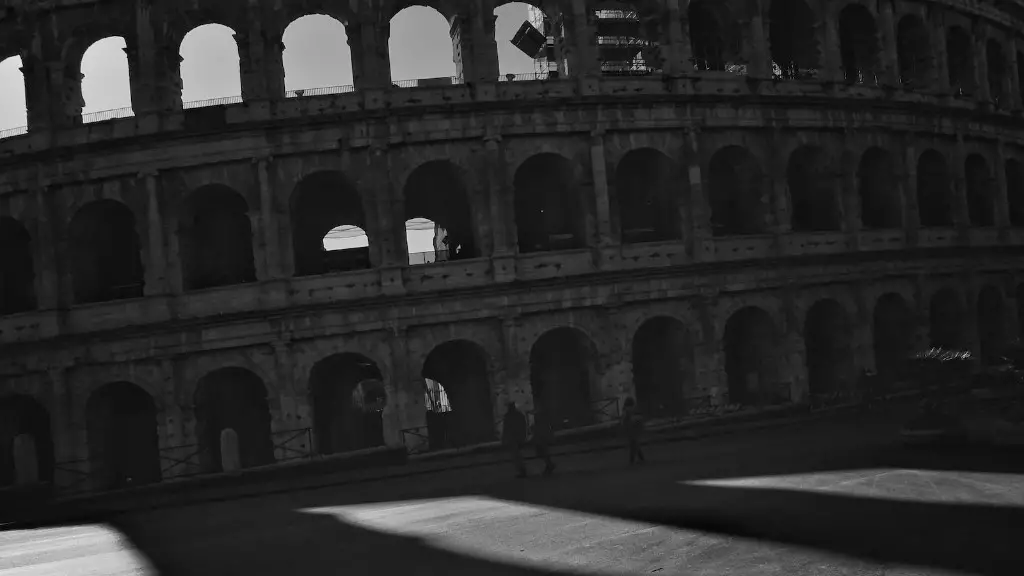The Ancient Roman Empire was a powerful and influential political and administrative force in ancient times, that stretched far beyond the current boundaries of the country. Among its many successes the empire was an advanced slaveholding society with an extensive machine of slavery. Ancient Rome relied heavily on slaves for a wide range of occupations and tasks, and slaves occupied privileged positions within the social and economic hierarchy in the city. This article explores the kinds of jobs that slaves did in ancient Rome, giving insight into the importance of slavery in Ancient Rome.
Slaves were usually divided into three main categories: domestic servants, farm workers and manual laborers. Domestic slaves in Ancient Rome were responsible for taking care of the households of the powerful and wealthy. This might include cleaning the house, running errands, preparing food, taking care of the children, and performing other tasks as requested. Farm workers were responsible for tending the fields and harvesting the crops, as well as taking care of the animals. Manual laborers were responsible for the tough and dangerous tasks, such as building roads and monuments. Manual laborers often worked in quarries, mines and public works projects.
In addition to these three main categories there was a fourth, specialized category, known as artifices. These were slaves who had been trained to do a specific task, such as carpentry, masonry, metalwork, and other skilled crafts. These slaves were highly sought after and their services commanding heavy prices.These slaves could be trained to perform all types of skilled labor such as painting, sculpting, and carving, but they were also sometimes trained in more unusual, dangerous and labor-intensive arts such as glass-blowing and metal-working.
Slaves who worked in the households of the wealthy were generally well-treated, as were those who worked in the fields. It was the manual laborers and artifices who were often mistreated and put in difficult and dangerous working conditions. In addition to this, slaves were not allowed to be educated or to receive any kind of leisure activities. They were expected to put in long hours and worked without any kind of protection from the law.
The rise and fall of the Roman Empire and the importance it placed on slavery has had a long-lasting effect on the history of the Western world. The legacy of Ancient Rome’s reliance on slavery has been deeply embedded in our culture, and can be seen throughout the language, literature and art of our time. It is important to remember that many of the things we enjoy today have their roots in the system of slave labor in Ancient Rome.
Choose of Jobs for Slaves
Slaves in Ancient Rome had very little freedom and choice in the kind of job they were assigned to. Most slaves were bought as assets by their masters and were either assigned to serve in their household or to labor in the fields. Some slaves were chosen for their strength, while others were chosen for their physical qualities and abilities. Slaves that had certain skills or abilities, such as those trained in a specialized task, were often more highly prized and commanded a higher price than those without any specialized abilities.
In certain cases, slaves were given the right to choose what job they wanted to perform, if they could prove that they had the necessary skills. This was uncommon, however, and slaves were usually assigned one of the three main categories of labor in Ancient Rome.
Slaves were not provided with any legal protection and were not allowed to own anything or to keep any kind of possessions. They were also not allowed to marry, own property, or to have any kind of rights. In addition to this, slaves were subject to harsh punishments if they were found to be in violation of any of their masters’ rules.
Life as a Slave in Ancient Rome
The life of a slave in Ancient Rome was hard and miserable. Slaves were considered to be less than human and were rarely ever given any kind of respect or dignity. They were owned by their masters and often worked long hours with no breaks. Slaves were not provided with any kind of protection from their masters and could be beaten, whipped or even killed if they failed to meet the expectations of their masters.
Slaves in Ancient Rome had no legal rights and could not enter into any kind of legal contract or agreement. They were also not allowed to own any kind of property or to be educated. This meant that slaves in Ancient Rome could not rise in social standing or gain wealth and power.
Slaves in Ancient Rome were viewed as a status symbol by their masters. They were often given expensive jewelry and dressed in fine garments as a sign of their masters’ wealth and power. Slaves were not given the same rights as other citizens and were considered to be property.
Slaves in the Roman Military
Slaves were commonly used in the Roman military, where they were assigned to a variety of tasks. They were responsible for carrying supplies, setting up camp, and sometimes even participating in battles. Slaves were also used as spies and messengers, and were occasionally assigned to specific tasks such as scouting. However, a slave’s military service was generally limited and they were rarely ever given any kind of recognition or honor.
Slaves that survived their military service were generally either released into freedom or given emancipation. Sometimes, they were even granted citizenship and allowed to become part of the Roman society. In other cases, they were made free men but still remained slaves to their former masters.
Slaves in the Roman military were treated somewhat better than those in other occupations, but it was still a harsh and dangerous life. They were often placed in dangerous situations and were expected to fight for their masters with complete obedience.
Slaves in the Gladiatorial Games
Slaves were commonly used in the Roman gladiatorial games, where they were pitted against each other or against fearsome beasts in bloody and violent contests. The gladiatorial games were seen as a form of entertainment for the Romans and were often popularly attended. Those who performed in the gladiatorial games were usually well-trained and usually had some form of protection from their masters. Despite this, the slaves in the gladiatorial games were still seen as disposable property and were often discarded after they had served their purpose.
Slaves in the gladiatorial games were often pitted against each other in a fight to the death and it is estimated that thousands of slaves died in these games. Some historians have argued that these games allowed slaves to gain some form of freedom, as some slaves gained fame and wealth through these contests, but it is clear that the gladiatorial games were cruel and barbaric.
The Abolition of Slavery in Ancient Rome
The slavery of Ancient Rome was eventually abolished by the Emperor Constantine in AD 313, when he declared that slavery was illegal and all slaves were to be set free. This was a groundbreaking move for the Roman Empire, and for the first time in history, slaves were given the same legal protection and rights that were to all citizens.
The emancipation of slaves in Ancient Rome would have an immense effect on the country and its citizens. Although slavery was outlawed throughout the empire, it would still take years before it was completely abolished and up until the 19th century, slavery and the oppression of slaves was still common throughout the Western world.
The Long-Term Effects of Slavery in Ancient Rome
The long-term effects of Ancient Roman slavery were wide-reaching and profound. While the immediate consequences of Constantine’s abolition of slavery were positive, it is clear that the legacy of slavery left a dark stain on the Roman Empire for centuries to come. Through slavery, Ancient Rome gained immense wealth, power and influence, but in the long run, this reliance on slavery would come back to haunt them and the wider Western world.
The slave trade has had an enduring effect on the development of our society, and it is clear that slavery has played an important role in our history. It is important to remember the mistakes of the past and to understand the consequences of slavery in order to ensure that we never repeat the same mistakes.
Conclusion
Slaves in Ancient Rome played a significant role in the economy and the development of the Roman Empire. They were used in a wide range of occupations, from domestic service and manual labor, to specialized crafts and gladiatorial games. Slaves had no rights or legal protection and were often mistreated and abused. The effects of slavery in Ancient Rome were long-lasting and can still be seen in our modern world. It is important to remember the cost of slavery and to ensure that we never make the same mistakes again.





